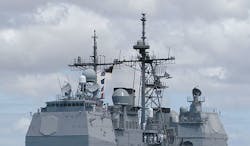Navy to pour more time and money into shipboard antenna project to cut RF cross interference
ARLINGTON, Va., 12 June 2014. U.S. Navy shipboard electronics experts are pouring additional time and money into a project to cut RF interference among ship-based antennas by reducing the number of radar antennas on Navy ships by using integrated, multi-function, multi-beam arrays.
Officials of the Office of Naval Research (ONR) in Arlington, Va., announced a plan Wednesday to add more than two years and four new kinds of jobs to the Integrated Topside (InTop) shipboard antenna program, which is developing integrated shipboard RF antennas that can handle several different warfare areas.
The InTop program extension will add 24 months to the program, yet will not increase the contract ceiling for existing contracts, which range from $50 million to $800 million, Navy officials say. The Navy has a stable of 18 companies working on different InTop tasks.
The InTop program seeks to develop and demonstrate common RF apertures and supporting subsystems that can perform several different functions in an effort to reduce RF interference among the forests of antennas on the superstructures of modern surface warships. The idea is fewer antennas will produce less cross RF interference.
The 18 InTop contractors are:
-- ATK Space Systems in Dayton, Ohio;
-- Argon ST in Fairfax, Va.;
-- BAE Systems in Nashua, N.H.;
-- Ball Aerospace & Technologies Corp. in Broomfield, Colo.;
-- Boeing Co. in Seattle;
-- Cobham Defense Systems in Landsdale, Pa.;
-- Colorado Engineering Inc. in Colorado Springs, Colo.;
-- DRS Signal Solutions Inc. in Gaithersburg, Md.;
-- Exelis Electronic Systems & Radar Systems in Van Nuys, Calif.;
-- Exelis Force Protection Systems in Thousand Oaks, Calif.;
-- FTL Systems Inc. in Rochester, Minn.;
-- General Dynamics Advanced Information Systems in Fairfax, Va.;
-- HYPRES Inc. in Elmsford, N.Y.;
-- Lockheed Martin Corp. in Moorestown, N.J.;
-- Northrop Grumman Corp. in Baltimore;
-- Raytheon Co. in Tewksbury, Mass.;
-- S2 Corp. in Bozeman, Mont.; and
-- Southwest Research Institute in San Antonio, Texas.
The InTop program seeks to dominate the RF spectrum and create affordable, scalable antennas and antenna subsystems on Navy surface ships and submarines not only for radar, but also for electronic warfare (EW) and RF communications systems.
A growing number of antennas aboard today's surface combatants has led to problems with electro-magnetic interference (EMI), radar cross sections, and the overall performance of shipboard electronic warfare, radar, and communications systems.
Two years ago ONR researchers asked the InTop contractors to work on developing a scalable family of radar antennas for several classes of Navy surface warships and submarines, as part of the InTop Flexible Distributed Array Radar (FlexDAR) concept.
Now Navy researchers are asking the InTop contractors to turn their attention to four new tasks involving air studies; modeling and experimentation; identification friend-or-foe (IFF); and multi-signal linear transmitter technology.
Air studies involves developing airborne multifunction capability for anti-access, area-denial (A2AD) strategies, and to provide systems for future aircraft that support this kind of capability.
Related: Northrop Grumman chooses Curtiss-Wright digital radio equipment for Navy InTop program
Modeling and experimentation involves demonstrations of InTop-like systems in an operational environment to run different scenarios repetitively. IFF seeks to address obsolescence issues in Navy RF systems. Multi-signal linear transmitters, meanwhile, seeks to build a system that can provide several different simultaneous communications links.
For questions contact ONR's Lynn Christian by phone at 703-696-1575, or by email at [email protected]. More information is online at https://www.fbo.gov/spg/DON/ONR/ONR/N00014-09-R-0002/listing.html.

